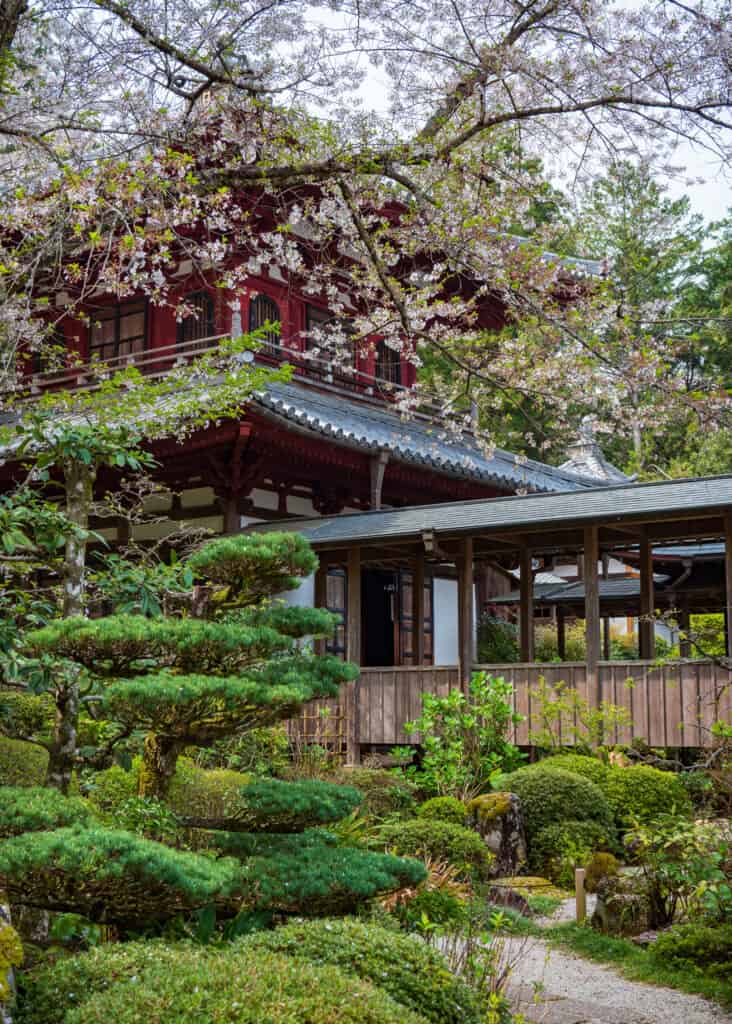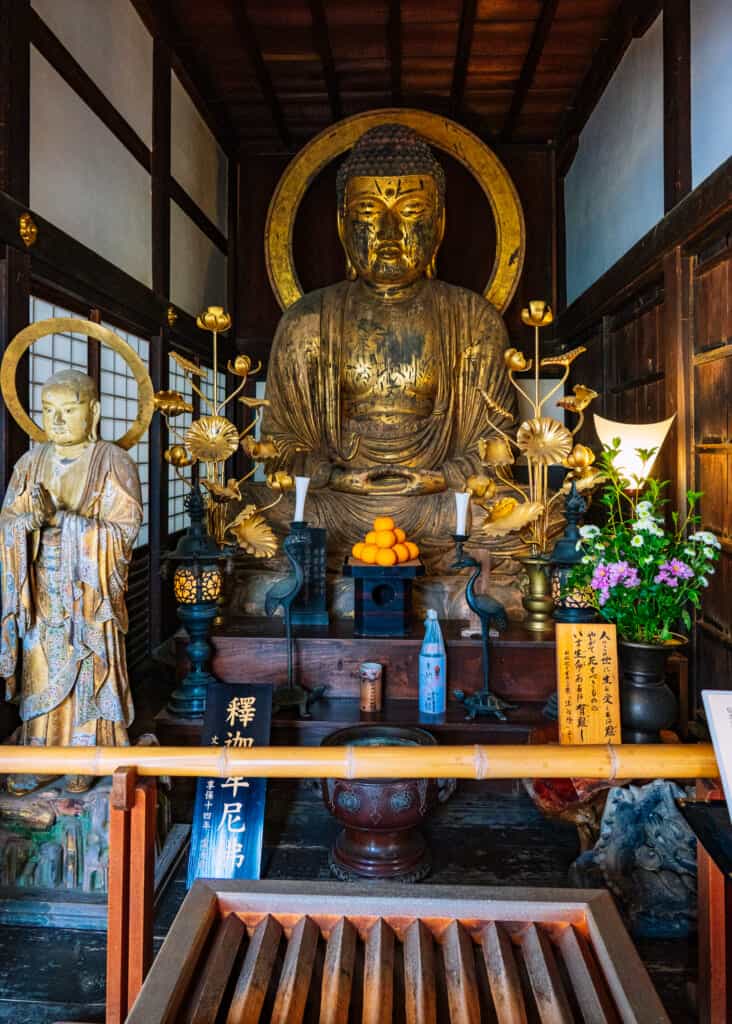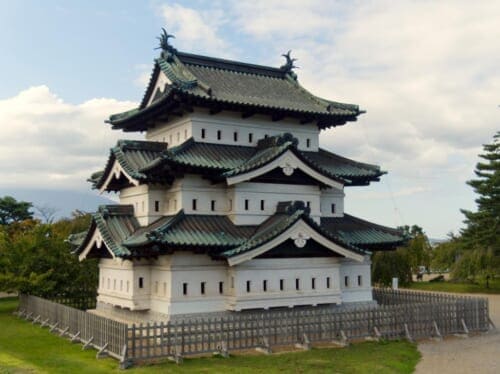“A Japanese is born as a Shinto, marries as a Christian, and dies as a Buddhist.” This looks impossible, but in Japan, it has its logic. The concept of spirituality and religion in Japan is different from what we are used to in the West, so it is very interesting to learn about it. But be careful: once you are onboard the Japanese religion’s train, you won’t be able to stop. You must be willing to learn more to better understand its culture and society. So, travel with us as we learn the differences between Buddhism, Shintoism, and the other religions coexisting in Japan!
- Religion in Japan: What is the Main Religion?
- Where Can I Practice My Religion in Japan?
- Eating in Japan with Religious Restrictions
Religion in Japan: What is the Main Religion?
According to the 2021 official document of the Ministry of Internal Affairs and Communications, there are 48.1% of inhabitants in Japan consider themselves Shintoists and 46.5% Buddhists. There is only 1.05% of Christians, and the other 4.3% include other religions. This data doesn’t seem out of the ordinary until we see that this statistic has been made according to 181 million people, and Japan only has 126 million inhabitants. How is it possible? The answer is that many people consider themselves both Shinto and Buddhist and therefore choose both.
As you can see, Shintoism and Buddhism have great relevance in Japan. Their synchronicity over the years has made them coexist in the same country and influence each other.
Shintoism: The Indigenous Religion of Japan
The word Shinto (神道 — Shintoism) literally means the deity path. The first kanji 神 means kami (deity, spirit), and the second 道 is michi (way).

What is Shintoism?
Shintoism is a religion that follows the cult of kami (spirits). It has greatly influenced Japanese culture for more than 2,000 years, thus being the basis of Japanese thinking. This religion has its rituals and ways of expressing gratitude to the kami. Despite this, it has no founder, no supreme God, and no sacred scriptures.
This is one of the few archaic religions that still survive in the modern world, and it has never been in danger of disappearing due to the threat of a more powerful religion. Buddhism was the only religion that could overshadow it, but both have been able to adapt and influence each other in such a way to mix traditions, rituals, and representative figures.

Even though we can find similar religions in other countries, such as Chinese Taoism, the Shinto religion itself only exists in Japanese culture. Japan is the only country that considers Shinto as an official religion. We just can find a few small shrines (called kaigai jinja — shrines outside the country) in countries where there has been a lot of Japanese immigration, such as Hawaii, Brazil, and the United States. At the same time, Shinto has no missionaries in other countries. We can say that Shintoism is completely rooted in the Japanese archipelago and its inhabitants. It is a way of understanding the environment, nature, the elements, and even the Japanese status quo and its emperor.


Is a Kami a God?
A kami is not the same as the omnipresent Western God we know. We can define them as powerful spirits superior to mortals.
These Japanese spirits can be in many ways, and their numbers are endless. There are important gods such as the Sun Goddess Amaterasu, spirits living within living beings (animals), elements of nature (mountains or a storm), and deceased ancestors, including the ancient emperors of Japan.
A kami usually lives inside an object (shintai — 神 体) like a mirror, a jewel, a sword, and is stored in a hidden box located in the main shrine building. But others are hidden inside a tree or a mountain. There are some of them where they are stored within a kami itself, such as Mount Fuji.


What is the Origin of Shinto Religion?
Shinto is as old as the Japanese civilization. In the prehistoric Jomon period (14,500 BC — 300 BC), each community living in the Japanese archipelago had its own animistic beliefs. They also interpreted the surrounding unexplained events, believing powerful spirits and ancestors made it.
When they established the Yamato state (the first Japanese nation), they decided to unify these small beliefs to impose a “single truth.” The history of Japanese mythology was compiled in Kojiki, Japan’s oldest book. Here, they explained the beginnings of human existence according to Shintoism and linked these higher divinities with the Japanese royal family. It is good to remember that, according to Shinto, the emperor and his family are descendants of the sun goddess Amaterasu and therefore have the legitimacy to reign in Japan.

Is Shinto a Symbol of Japanese Nationalism?
Shintoism is a true symbol of Japanese identity. In certain periods of history, it has been used by Japanese nationalists.
The Meiji Restoration is the most recent period of history when Shinto was used for non-religious purposes. Some purists of Japanese society wanted to impose Shinto as the only religion in Japan and even tried to suppress Buddhism. During this period, Shinto shrines became part of state institutions run by the government, which was the ones making decisions. This was called the State Shinto and lasted until the end of WWII.
After that, the government abolished the State Shinto, yet the relationship between Japanese nationalism and Shinto still has its open wounds. The clearest example is the Yasukuni Shrine in Tokyo. This shrine was created in 1869 to honor the soldiers who died during the Boshin War. Since then, as we explained in our yurei ghosts article, many of the war fighters have been enshrined as kami there, including World War II criminal war soldiers. This seems an old story, but even nowadays, some Japanese prime ministers have visited this shrine to pay their respects on behalf of the government.
 Yasukuni-jinja Shrine
Yasukuni-jinja Shrine
ESTABLISHMENT PLACE_OF_WORSHIP POINT_OF_INTEREST- 3-chōme-1-1 Kudankita, Chiyoda City, Tokyo 102-0073, Japan
- ★★★★☆
Shinto Shrines to Visit in Japan
The sacred place for Shintoists is the kami‘s dwell, a shrine (神社 — jinja). Unlike other religions, sanctuaries are built in the place where the spirit is believed to live. This can answer why there are many sanctuaries in hidden and surprising places. Some shrines to visit in Japan are:
- Izumo Taisha Shrine is said to be one of the oldest in Japan.
- Fushimi Inari Taisha is dedicated to the fertility kami Inari.
- Kibitsu Shrine in Okayama, with an impressive 400-meter-long covered walkway.
- The mysterious Omotoro Shrine.
- Usa Jingu Shrine in Oita Prefecture.
- Several curious shrines in Osaka.
Buddhism: Another Religion in Japan
The philosophical doctrine of Buddhism was created by Siddhartha Gautama (Buddha) in India (VI — IV BC). Buddha is not considered a supreme god, but as someone who reached a very high spiritual level, worth following his teachings. Buddhism has influenced the spirituality and behavior of many Asian countries, including Japan, and that makes it one of the most widely followed religions in the world. The Buddhist religion has some doctrines, and following them can lead you to complete happiness.



How did Buddhism Come to Japan?
Buddhism was established in Japan during the Nara Period (710-794), in the 6th century during Emperor Kinmei’s reign. Thanks to the support of important families, the pro-Buddhist emperor Shomu built Todaiji Temple in Nara, a symbol and hub of a network of Buddhist temples around Japan. This was how Buddhism was rooted in Japanese society until today. Throughout history, some Buddhist schools had more powers beyond religion, reaching to politics and the imperial court. But in the Sengoku period, Buddhism was forced to abandon that power and focus on religion.
Buddhist Schools in Japan
Over the years, Buddhism has been creating schools of the different Buddhist sects. One of the most well-known is Shingon, an esoteric Buddhism current with the Japanese religious center in Koyasan. Another well-known Buddhist current is Pure Land Buddhism, devoted to educating and expanding Buddhism ideas to the lower classes of the Japanese society during the Kamakura period. This school says that you can receive salvation by commending yourself to Amida Buddha by saying his name. The last school we will mention is the world-famous Zen, originating from China’s Chan Buddhism and divided into two ways: Rinzai (which emphasizes koan practice during meditation) and soto (which emphasizes sitting with open consciousness). Zen focuses on meditation, following daily tasks, and knowing yourself to achieve enlightenment.

Death in Japanese Buddhism
Shinto considers death as something negative, but when Buddhism arrived in Japan, the funerary rituals of both religions adapted themselves. Shinto priests rarely performed the deceased rituals, so Buddhist monks started the task of carrying out these funerary rituals. From the Tokugawa government, this was compulsory, as Buddhist monks were ordered to bury the deceased.
Nowadays, in Japan, you can choose both a Shinto or a Buddhist ritual. Even so, the majority of Japanese citizens choose the second option. Besides funerary rituals, Buddhism has more celebrations related to death and the spirits of the deceased ones, such as Obon.


Buddhist Temples to Visit in Japan
A temple is the place of worship for Buddhists. They can be identified by their big doors, the manji symbol (卍), and other distinctive aspects. Some temples to visit in Japan are:
- The mysterious Futagoji in Oita Prefecture is located in the depths of a mountain.
- The enormous Shingon temple in Koyasan, Wakayama Prefecture.
- Katsuo-ji in Osaka, the temple of daruma.
- The previously mentioned Todai-ji in Nara.
- Hojo-ji in Hamamatsu where you can live a Zen meditation experience.

Where Can I Practice my Religion in Japan?
Religion in Japan goes further than Shinto and Buddhism. Even though existing more than 80,000 shrines and 75,000 temples, there are other places of worship for other religions in many cities.
Churches and Cathedrals in Japan
Nowadays, just 1 % of the Japanese population considers themselves Christian. Christianity arrived in Japan in the 16th century thanks to the European missionaries. After a few rooting decades in the country, the Edo period government forbade it and expelled the vast majority of missionaries living in Japan. It wasn’t till the 19th century that Christianity was allowed again.
In some areas, including many sites on Kyushu island, such as Nagasaki’s Goto Islands, you will find some Christian legacy existing in Japan. Moreover, in many main cities, there are many catholic churches and cathedrals, such as the modern St. Mary of the Immaculate Conception Cathedral in Tokyo, with its surprising architecture designed by Kenzo Tange. Also, there are Orthodox churches and cathedrals such as the Holy Resurrection Cathedral and Anglican as Saint Andrew’s Cathedral.
Mosques in Japan
Islam had a negative connotation in 1853 Japan when the Edo period ended, and the country opened its borders to the rest of the world. One hundred years later, the first Japan Muslim Association was created. Even though it is a minority religion in Japan, the number of Muslims has highly increased recently, reaching 230,000 in 2019. 50,000 of them are converted Japanese.
There are about 80 mosques in Japan, some of them are big buildings, and others are small rooms, and most of them are located in large cities. For example, we have Tokyo Camii in Tokyo, the Kobe Mosque, or the Fukuoka Mosque.
Synagogues in Japan
There are still small communities of Jew people, even though many of them emigrate to Israel after the Second World War. One of the biggest communities is Kobe’s one, the Jewish Community of Kansai, where ex-pats or Jews taking a sabbatical year live. There is also a community in Tokyo (Chabad-Lubavitch), en Kyoto (Chabad Kyoto), and in Gifu Prefecture (Chabad Takayama).
Also, in the small town of Yaotsu (Gifu Prefecture), there is the Chiune Sugihara Memorial Museum, where Chiune Sugihara was born. This Japanese diplomatic rescued 5558 Jews during the Holocaust, offering them Japanese visas to stay in Japan to save their lives. Besides visiting the museum, there is Sugihara’s tomb in Kamakura, and many Jews visit it to pay tribute.
Eating in Japan with Religious Restrictions
In this last section, we will talk about what and where to eat in Japan if we have a halal or a kosher diet.
Where to Eat Halal Food in Japan
For those Muslims following a halal diet, there are two options: you can look for a halal product shop to prepare your own food or look for halal restaurants previously.
You have to remember that many Japanese dishes include pork, even if it doesn’t look like it. For example, many types of ramen are made with pork, so the safest alternative is to choose a vegetarian or chicken ramen. You can also order tempura or other vegetarian Japanese menu items.
Halal Restaurants in Tokyo
There are also many restaurants with halal food. For example, in Tokyo, you can visit many restaurants such as: Honolu Ramen (there is another one in Osaka), Gyuumon (halal beef meat), or Tokyo Chinese Muslim Restaurant (halal Chinese food). If you want to try a halal curry, you can go to Coco Ichibanya in Shinjuku or Akihabara, or if you prefer sushi, you can go to Asakusa Sushi Ken (the first halal sushi in Tokyo).
Halal Restaurants in Osaka
In Osaka, there is Naritaya Osaka Minami (with ramen and other halal dishes), Matsuri restaurant (with many muslim friendly dishes).
Halal Restaurants in Kyoto
In the ancient capital, you can also find halal places. If you want to try tofu with a halal menu, you can go to Okabeya, and to try a variety of Japanese food, visit Yoshiya Arashiyama restaurant.
If you want to look for more halal restaurants, you can check out this website with a big search engine where you can choose many categories.
Where to Eat Kosher Food in Japan
In Japan, there aren’t many places where you can find kosher food. Even so, thanks to Chabad Lubavitch website, there are some kosher shops in Tokyo:
- National Azabu Supermarket in Azabu neighborhood in Tokyo.
- Nissin World Delicatessen.
- Chana’s place, in Minato neighborhood in Tokyo.
- Delica Restaurant.
In addition, the same website provides us with a list of kosher fish, with Japanese and English translations.
Your trip to Japanese spirituality just started. I wish you want to keep discovering more curiosities about religions in Japan and use all this knowledge for your next trip to Japan.
For this article, I have used as a reference these books: “Shinto: the Kami way” by Sokyo Ono and Japanese History by Brett L. Walker.












No Comments yet!